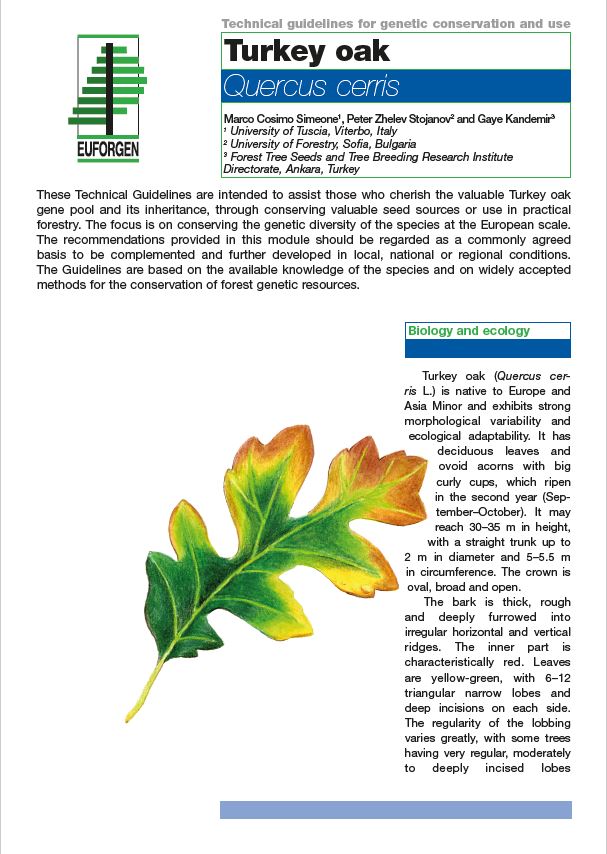Quercus cerris - Technical guidelines for genetic conservation of Turkey oak
Concerning Q. cerris wild populations, special care should be taken regarding habitat conservation, soil protection and water regime management. As for managed stands, Q. cerris grows well within a high forest system, which would in itself be a good measure for the species protection. To preserve soil fertility and increase stand biodiversity, traditional coppice systems, performed with short rotation regimes (20 years), should be replaced by longer rotation time periods of about 25–30 years, with 1000–2000 stumps/ha and preserving at least 80 seeding trees/ha. This practice is suggested especially to small private farms, and where the ecological conditions are not completely favourable. Coppice conversion to high forests requires a felling after 50–80 years’ delay, leaving 80–130 seed bearing trees/ha, if there are optimal conditions for natural regeneration (good soil fertility, low density of healthy standards), or 30-50 years and 170–200 seed bearing trees/ha in over-exploited stands or where natural regeneration is poor. In high forests for production, even-aged populations are preferred, in order to reduce competition among individuals of different sizes. Since Turkey oak wood is not valuable, high forest management, with shelter wood felling on small areas and short periods dedicated to regeneration, is the management system generally adopted. Where regeneration is naturally poor, working the soil (superficially), removing the understorey and plantation of new seedlings are good options. Grazing should in any case be avoided. For natural regeneration, 70–80 seed bearing trees/ha (80–150 with diameter < 50 cm), should be preserved at every felling. Thinning should be performed between 80 and 100 years. After 150 years, the only care suggested is to remove damaged and unhealthy individuals. Mixed forests with 150-200 individuals/ha and natural co-occurrence of native tree species should be pursued.
For Q. cerris, in situ conservation methods based on natural regeneration are generally preferred. If natural regeneration is not sufficient, the use of non-native reproductive material can be only exceptionally accepted, and it should be transferred only at a local scale, based on the detected species’ genetic structure. Transfers among provenance regions must be strictly avoided.
If in situ methods are not sufficient, an ex situ conservation programme should also be applied to preserve the endangered gene pool. Ex situ programmes should be adapted to local conditions, such as population structure; forestry practices; economic, political and social situations, etc.
In the case of intensive use of forest reproductive material (FRM)—acorns, seedlings raised or lifted—the rules and requirements of EC legislation for FRM and/or OECD Forestry Scheme shall be primarily applied or adapted.
Due to its adaptive potential, Turkey oak might have an increasing role in present and future sub-Mediterranean regions, which may be important in the context of climate change. Given the genetic information available, it is recommended that conservation programmes start with the following objectives: conservation of endangered, marginal populations and habitats of Q. cerris; protection of the identified genetic variants; establishment of Genetic Conservation Units based on long term autochthony, high biodiversity value and location in ecologically diverse regions of large populations
(> 1000 individuals).
Authors: Marco Cosimo Simeone; Peter Zhelev Stoyanov; Gaye Eren Kandemir
Journal/Series:
EUFORGEN Technical Guidelines for Genetic Conservation and Use
Publication Year: 2019
Publication Format: PDF
ISBN 13: 978-952-5980-43-1
Language: EN
Pages: 6 p.
Technical guidelines Quercus cerris

